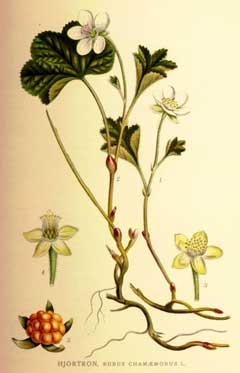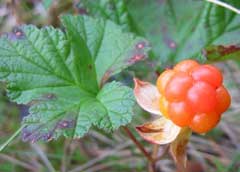 |
|
http://commons.wikimedia.org/wiki/File:Rubus_cham%C3%A6morus.jpg |
 |
|
Translate this page:
Summary
Physical Characteristics

 Rubus chamaemorus is a PERENNIAL growing to 0.3 m (1ft) by 1 m (3ft 3in).
Rubus chamaemorus is a PERENNIAL growing to 0.3 m (1ft) by 1 m (3ft 3in).
See above for USDA hardiness. It is hardy to UK zone 2. It is in flower from June to August, and the seeds ripen from July to September. The species is dioecious (individual flowers are either male or female, but only one sex is to be found on any one plant so both male and female plants must be grown if seed is required). and is pollinated by Bees, flies. The plant is not self-fertile.
Suitable for: light (sandy), medium (loamy) and heavy (clay) soils and prefers well-drained soil. Suitable pH: mildly acid and neutral soils and can grow in very acid soils.
It cannot grow in the shade. It prefers moist or wet soil.
UK Hardiness Map
US Hardiness Map
Synonyms
Plant Habitats
Woodland Garden Sunny Edge; Bog Garden; Cultivated Beds;
Edible Uses
Edible Parts: Flowers Fruit
Edible Uses: Tea
Fruit - raw or cooked[183, 257]. Sour but delicious, the fruit can be eaten out of hand or stewed, used in preserves, pies etc[183]. Rich in vitamin C[257]. The sweet fruit tastes like baked apples[207]. Flowers - raw. The fresh or dried leaves are used as a tea substitute.
References More on Edible Uses
Medicinal Uses
Plants For A Future can not take any responsibility for any adverse effects from the use of plants. Always seek advice from a professional before using a plant medicinally.
Febrifuge Infertility TB Vitamin C
A decoction of the roots has been used as 'woman's medicine'[257]. A decoction of the root and lower stem has been used by barren women to try and become pregnant[257]. The root has been used in the treatment of coughs, fevers and consumption[257].
References More on Medicinal Uses
The Bookshop: Edible Plant Books
Our Latest books on Perennial Plants For Food Forests and Permaculture Gardens in paperback or digital formats.

Edible Tropical Plants
Food Forest Plants for Hotter Conditions: 250+ Plants For Tropical Food Forests & Permaculture Gardens.
More

Edible Temperate Plants
Plants for Your Food Forest: 500 Plants for Temperate Food Forests & Permaculture Gardens.
More

More Books
PFAF have eight books available in paperback and digital formats. Browse the shop for more information.
Shop Now
Other Uses
Dye
A purple to dull blue dye is obtained from the fruit[168]. This species is used in breeding programmes for the raspberry (Rubus idaeus) in order to improve the fruit flavour[317
].
Special Uses
Food Forest
References More on Other Uses
Cultivation details
Easily grown in a good well-drained loamy soil in sun or semi-shade[1, 11, 200]. Avoids calcareous soils in the wild and is often found in boggy soils[17]. Considered to be a gourmet fruit, it is occasionally sold in speciality stores[183]. Dioecious. Male and female plants must be grown if seed is required. For polyculture design as well as the above-ground architecture (form - tree, shrub etc. and size shown above) information on the habit and root pattern is also useful and given here if available. The plant growth habit is a clumper with limited spread [1-2]. The root pattern is rhizomatous with underground stems sending roots and shoots along their length [1-2].
References Carbon Farming Information and Carbon Sequestration Information
Temperature Converter
Type a value in the Celsius field to convert the value to Fahrenheit:
Fahrenheit:
The PFAF Bookshop
Plants For A Future have a number of books available in paperback and digital form. Book titles include Edible Plants, Edible Perennials, Edible Trees,Edible Shrubs, Woodland Gardening, and Temperate Food Forest Plants. Our new book is Food Forest Plants For Hotter Conditions (Tropical and Sub-Tropical).
Shop Now
Plant Propagation
Seed - requires stratification and is best sown in early autumn in a cold frame. Stored seed requires one month stratification at about 3°c and is best sown as early as possible in the year. Prick out the seedlings when they are large enough to handle and grow on in a cold frame. Plant them out into their permanent positions in late spring of the following year. Cuttings of half-ripe wood, July/August in a frame[200]. Division in early spring or just before leaf-fall in the autumn[200].
Other Names
If available other names are mentioned here
Native Range
TEMPERATE ASIA: China, Eastern Siberia, Heilongjiang Sheng, Hokkaidô, Honshu, Japan, Jilin Sheng, Kamcatskij kraj, Kurile Islands, Liaoning Sheng, Primorye, Russian Federation, Russian Federation-Eastern Siberia, Sakhalin, Western Siberia,Russian Federation-Western Siberia. NORTHERN AMERICA: Canada, Northwest Territories, Yukon, Québec, Nova Scotia, Ontario, Prince Edward Island, New Brunswick, Newfoundland and Labrador, Saskatchewan, Alberta, Manitoba, British Columbia, Greenland, United States, Alaska, Connecticut, Maine, Massachusetts, New Hampshire, New York (north), Rhode Island, Vermont, Minnesota (north), EUROPE: Denmark, Finland, United Kingdom (U.K.), Ireland, Norway, Svalbard and Jan Mayen, Sweden, Germany, Poland, Russian Federation-European part, European part (incl. arctic region), Belarus, Estonia, Lithuania, Latvia,
Weed Potential
Right plant wrong place. We are currently updating this section.
Please note that a plant may be invasive in one area but may not in your area so it's worth checking.
Conservation Status
IUCN Red List of Threatened Plants Status :

Growth: S = slow M = medium F = fast. Soil: L = light (sandy) M = medium H = heavy (clay). pH: A = acid N = neutral B = basic (alkaline). Shade: F = full shade S = semi-shade N = no shade. Moisture: D = dry M = Moist We = wet Wa = water.
Now available:
Food Forest Plants for Mediterranean Conditions
350+ Perennial Plants For Mediterranean and Drier Food Forests and Permaculture Gardens.
[Paperback and eBook]
This is the third in Plants For A Future's series of plant guides for food forests tailored to
specific climate zones. Following volumes on temperate and tropical ecosystems, this book focuses
on species suited to Mediterranean conditions—regions with hot, dry summers and cool, wet winters,
often facing the added challenge of climate change.
Read More
Expert comment
Author
L.
Botanical References
1117200
Links / References
For a list of references used on this page please go here
Readers comment